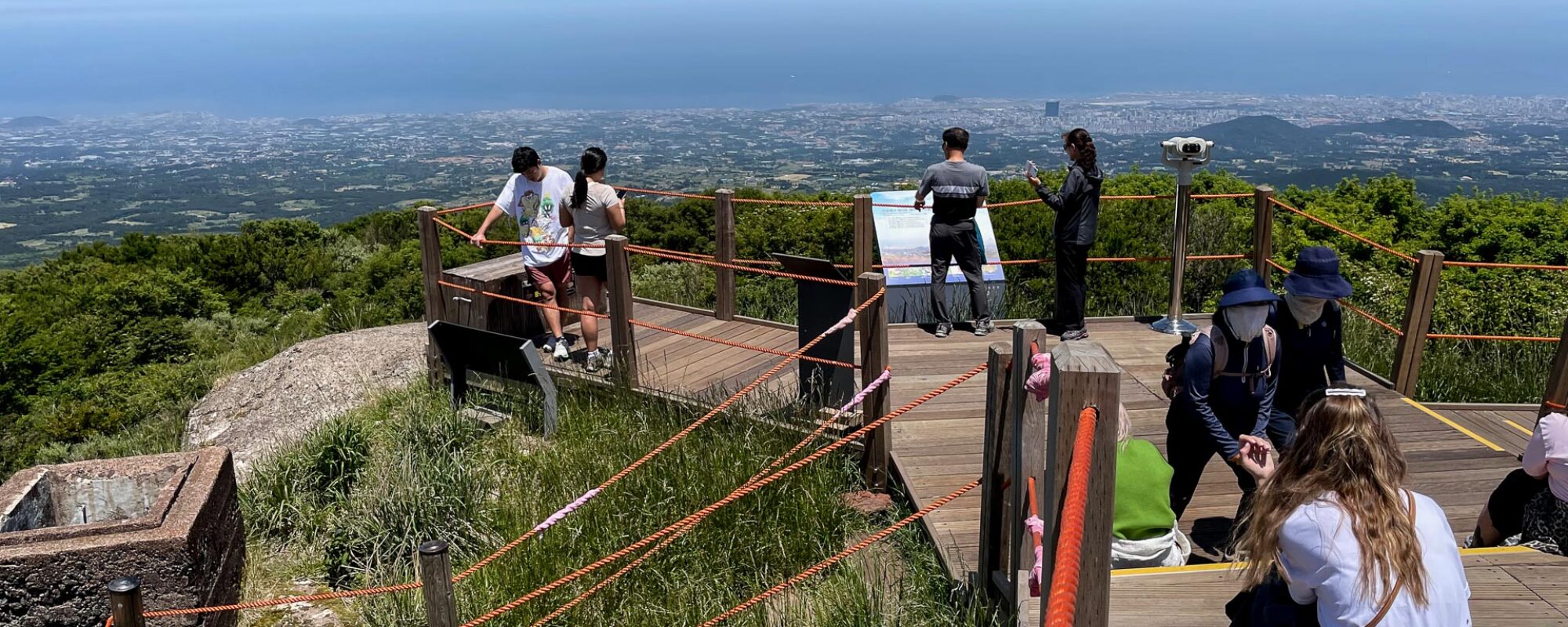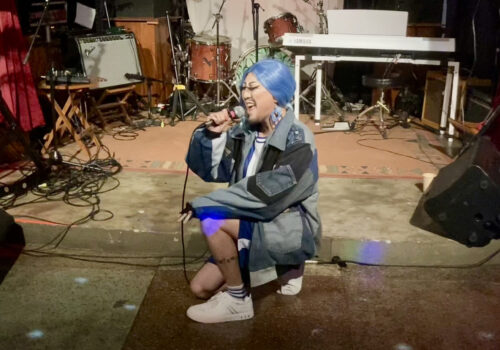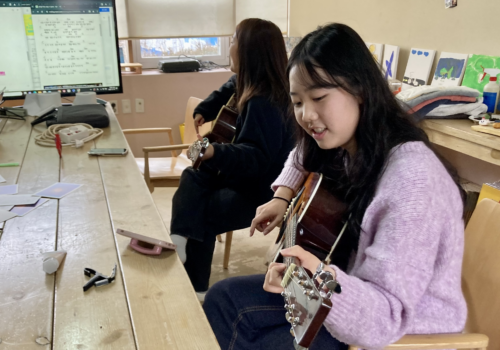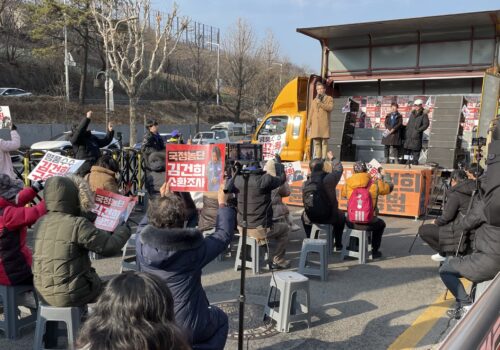SEOGWIPO, South Korea — On a sunny day in mid-May, I was driving with a friend through a small, seaside village on the northern coast of Jeju, an 1833-square-kilometer volcanic island south of the Korean peninsula, when we noticed an old woman waiting at a zebra crossing. My eyes followed her stooped figure rushing across the street, one hand pumping up and down in haste while the other held on to her wide-brimmed hat. It took a second before I realized where she was heading with such determination: to a quad bike mounted with a brightly colored plastic crate and a familiar net and buoy.
I gasped: “She’s a haenyeo!”
Jeju is famous for its haenyeo (해녀), women free-divers who collect seaweed, abalone, conches, sea urchins and other treasures from as deep as 10 meters underwater. This was only my second day on the island, and I’d already seen a few haenyeo hard at work. I was staying at a pension in Beophwan, a village on the southern coast, and every morning I opened the curtains to see a few of the divers’ buoys bobbing among the waves or a woman arranging seaweed to dry on the shore’s black volcanic rocks. But this was the first time I’d seen one of those famous divers on her commute to work.
She revved up her engine and sped ahead of us. It was already past noon, and the day was heating up, but a hazy fog lingered just beyond the jagged shoreline. For a short stretch, another bike flanked her, and then another and another, until the gang stopped along a bridge with bright yellow railing.
Out of curiosity, we stopped too and soon spotted a group of haenyeo sitting in a rough circle on the paved path leading down to the rocks. Sharp, joyful shouts in Jejuan, the local language, drifted up to us as the women joked around, loudly welcomed late arrivals and prepared for the afternoon shift. Hovering awkwardly by the bikes, I wondered if it would be okay to snap a photo—until I realized that several women were changing into swimsuits and wetsuits right there by the road.
A few hours earlier, I might have been alarmed to see an older woman suddenly strip off her shirt in plain view. But my friend and I had just left the Jeju Haenyeo Museum, a large exhibition hall in the eastern village of Sando-ri, where we’d learned about the divers’ rites, rituals and practices.
Recognized in 2016 by UNESCO as a form of intangible cultural heritage, haenyeo culture is known for its cooperative and sustainable use of ocean resources, and as a symbol of women’s strength and resilience. I’ve often heard haenyeo culture—and Jeju’s cultural respect for women and women’s work more broadly—referenced in contrast to the mainland’s history of gender inequality.
The gathering we witnessed would normally take place at a bulteok, a haenyeo dressing room traditionally built with walls of black stone. Haenyeo meet at bulteoks before and after dives to deepen community and strategize the work ahead.
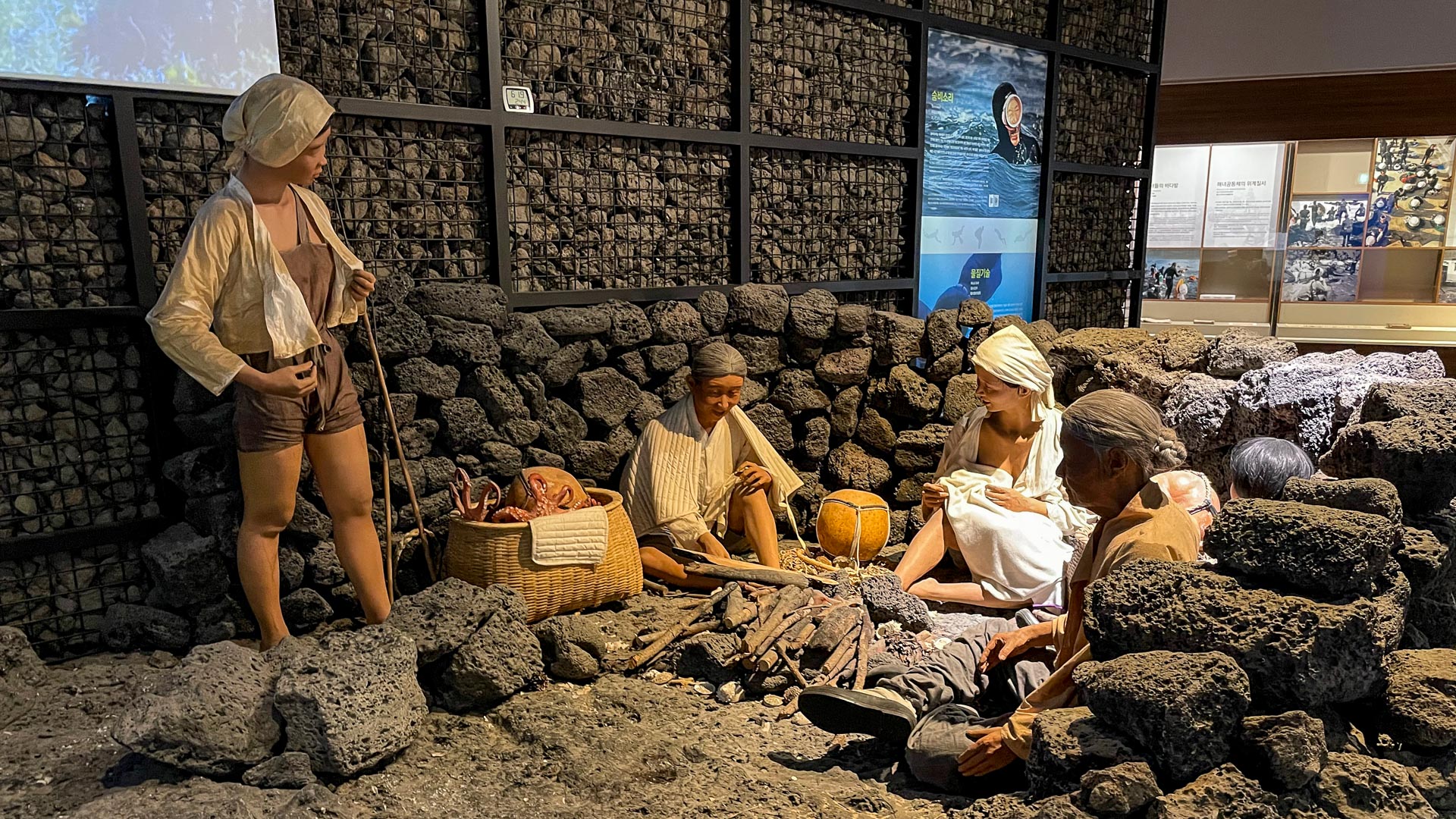
Good to know, and very cool to see in person—because haenyeo culture is actually at risk of dying out. Free-diving in Jeju’s choppy waters is dangerous due to its strain on the body and the likelihood of accidents. Mortality is high, so these days, fewer young women take up the trade. Most of the haenyeo working now are in their 70s and 80s.
This is what I was here for, what I was most excited to see and learn about during the trip: the things that make Jeju unique. My knowledge of Jeju was scattershot and vague. I knew it has a unique language that is similar to but not mutually intelligible with Korean. I knew its distance from the Korean peninsula kept it isolated for much of its history, leading to the development of a distinct culture. I knew its people struggled during the Joseon era, and again under Japan’s colonial-era forced labor schemes, and then again during a massacre by the newly minted Republic of Korea in 1948 and 1949, known as the Jeju 4.3 Incident.
But mostly, I’d heard how great the island is as an escape from normal life. In mainland South Korea, where Jeju is a popular honeymoon spot, any mention of travel there is met with excitement and envy: “Oh, it’s so beautiful and relaxing!” I imagined a land of infinite greenery, with sprawling agricultural lands and flower fields, untouched forests and beaches. I imagined that Hallasan—the highest peak in very mountainous South Korea, at 6,400 feet—would tower over the island like a titan. And I was excited to try local seafood dishes like galchi jorim (braised beltfish) and jeonbuk juk (abalone porridge), as well as its tangerines, which mainland Koreans hoard by the crateload every winter.
Well, the local dishes were just as good as I’d imagined, and I still regret not buying more Hallabong oranges. But the landscape and atmosphere were not what I expected. Driving from Jeju International Airport in the north to our pension in the south, I was surprised at the strip mall-style development of its main roads. We passed signs for hotels, pensions, theme parks, folk culture villages, museums, gardens and photo zones—a dizzying march of attractions for such a small island. Rather than tracts of untouched beauty, most of the attractions outside of Hallasan National Park are carefully landscaped and curated for tourists’ enjoyment, lending them a hint of artifice. There are so many things to do in each quadrant of the island that it’s difficult to choose where to start, let alone to commit to any long stretches of relaxation.
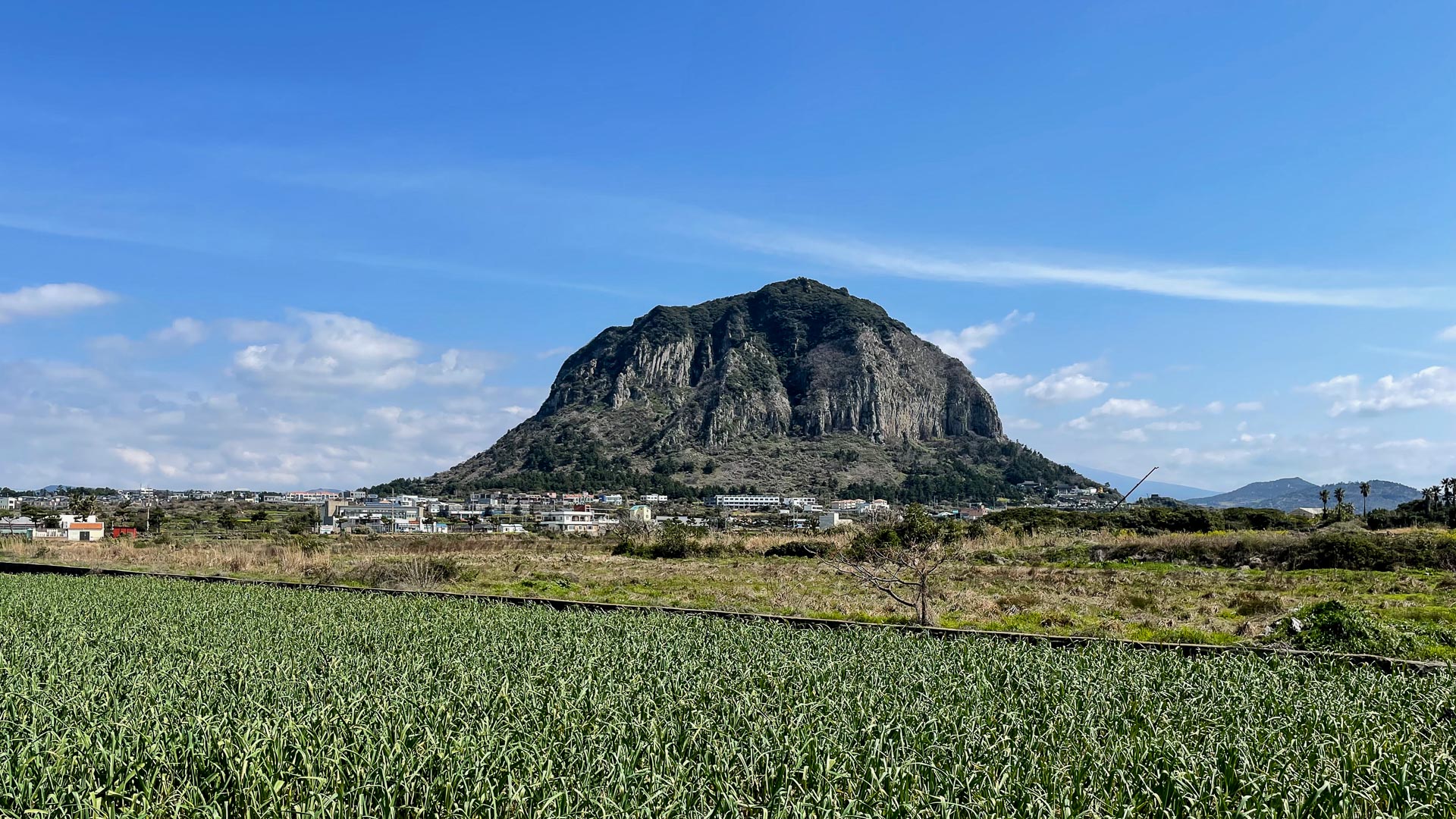
Less commercial areas offer more glimpses of Jeju’s famed natural beauty. The arched roofs of greenhouses sit next to overgrown squares of farmland and fields of brightly colored flowers, all fenced in with Jeju’s classic black rock walls. The olle walking trails that circle the island frequently wander off main roads onto dirt paths lined with brush and wildflowers, offering serene coastal views. On a clear day, the ancient, sleeping giant of Hallasan is indeed visible from all over, but more impressive are the hundreds of small, extinct volcanoes called oreums that jut up strangely from the flat lands between the mountain’s forests and the shore.
Still, to me, the dominant narrative of Jeju seemed to be not rest and retreat, but industry. The island’s locals must constantly grind and compete for every cent earned at its hundreds of businesses. This feeling only intensified as I learned more about Jeju’s history through exhibits at its cultural institutions, which present life as one of constant toil against unfavorable odds.
For much of its history, Jeju was defined by its distance, isolation and inhospitable nature. Even basic human needs like water and food were once hard to come by. Much of the island’s water lies trapped underground, and its porous soil prevents rainwater from collecting into streams. This also made it nearly impossible to farm there (though the Jeju people found a way). This is why many took up dangerous work like diving in the first place; before citrus farming developed in the mid-20th century, seafood was the most important part of Jeju’s economy.
Although the island has long traded with nearby lands, its frequent typhoons and powerful winds complicated communication and navigation and caused countless shipwrecks. During the Yuan Dynasty, mainlanders were exiled to Jeju. The Joseon Dynasty maintained this policy and additionally banned locals from traveling to the mainland. All this made Jeju seem mysterious and even dangerous to mainlanders, and reinforced locals’ sense that they could only rely on each other and the island’s scarce resources.
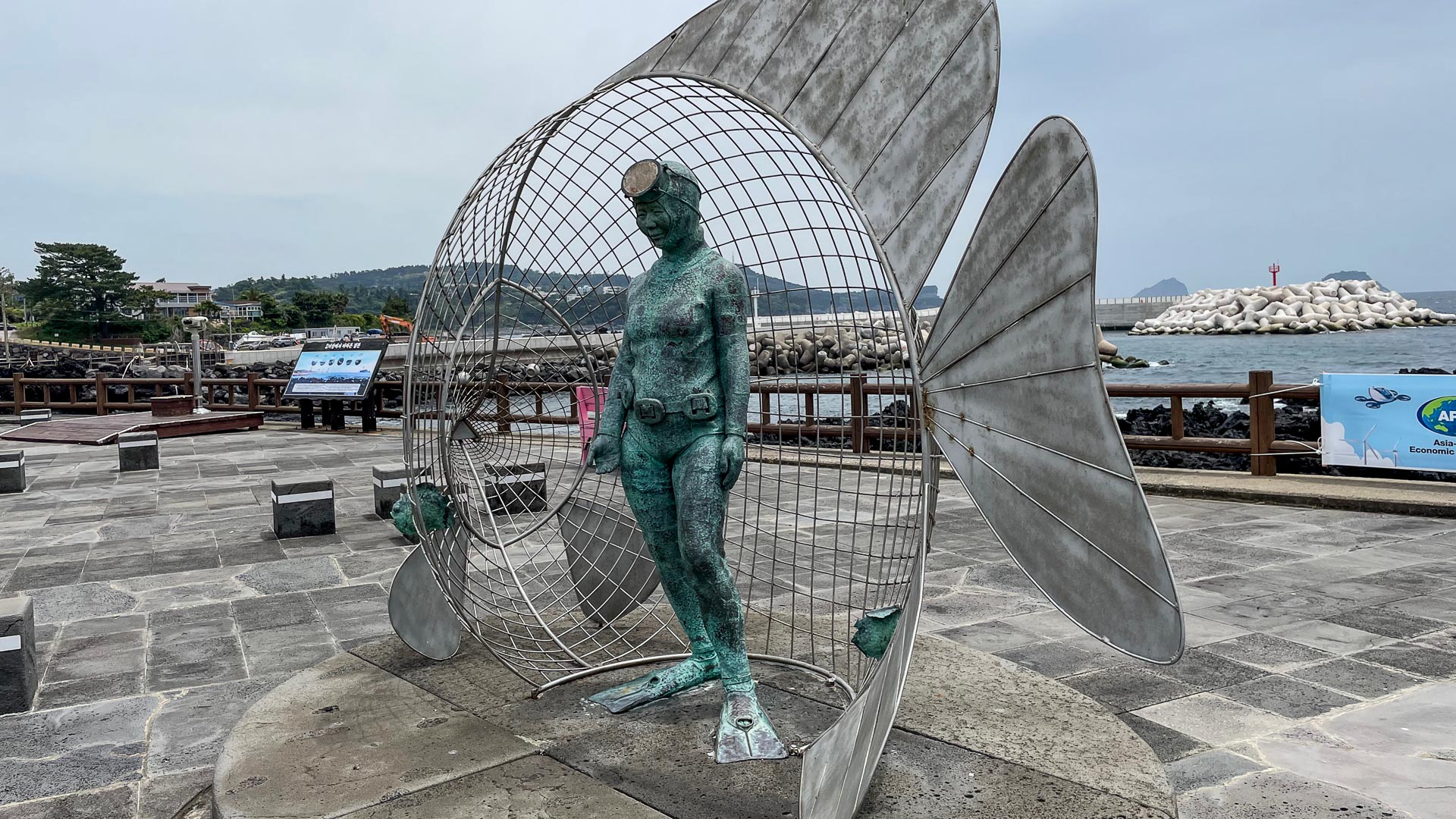
Kwon Mi-seon, a Jeju native and researcher at the Haenyeo Museum, recounted much of this history when I met her at the museum’s offices. Dressed plainly in a striped shirt and slacks, Kwon gave the impression that any minute wasted was a minute too many, leaning forward as she spoke and interrupting my slow Korean to hurry the conversation along.
When asked about the idea that haenyeo could be seen as feminist symbols of strength, Kwon noted that though the museum’s own materials portray the culture as an example of “ecofeminism,” she doesn’t really see it that way.
“I don’t think it’s right to go all the way to feminism. It’s just a traditional fishing industry that women have traditionally done,” Kwon said, sitting back in her seat with a small laugh. “Because of the natural environment, we had no choice but to find resources from the sea.”
In a matter-of-fact tone, she explained that Jeju’s women have long been tasked with gathering spring water along the coast, and while there would often collect abalone and seaweed for cooking. During the more unstable moments in Jeju’s history, when men were sent into war or forced labor, the women of Jeju saw earning a living from the sea as the “obvious” choice.
In other words, throughout their history, Jeju’s people have simply done whatever had to be done to survive their circumstances, and the culture has adapted accordingly.
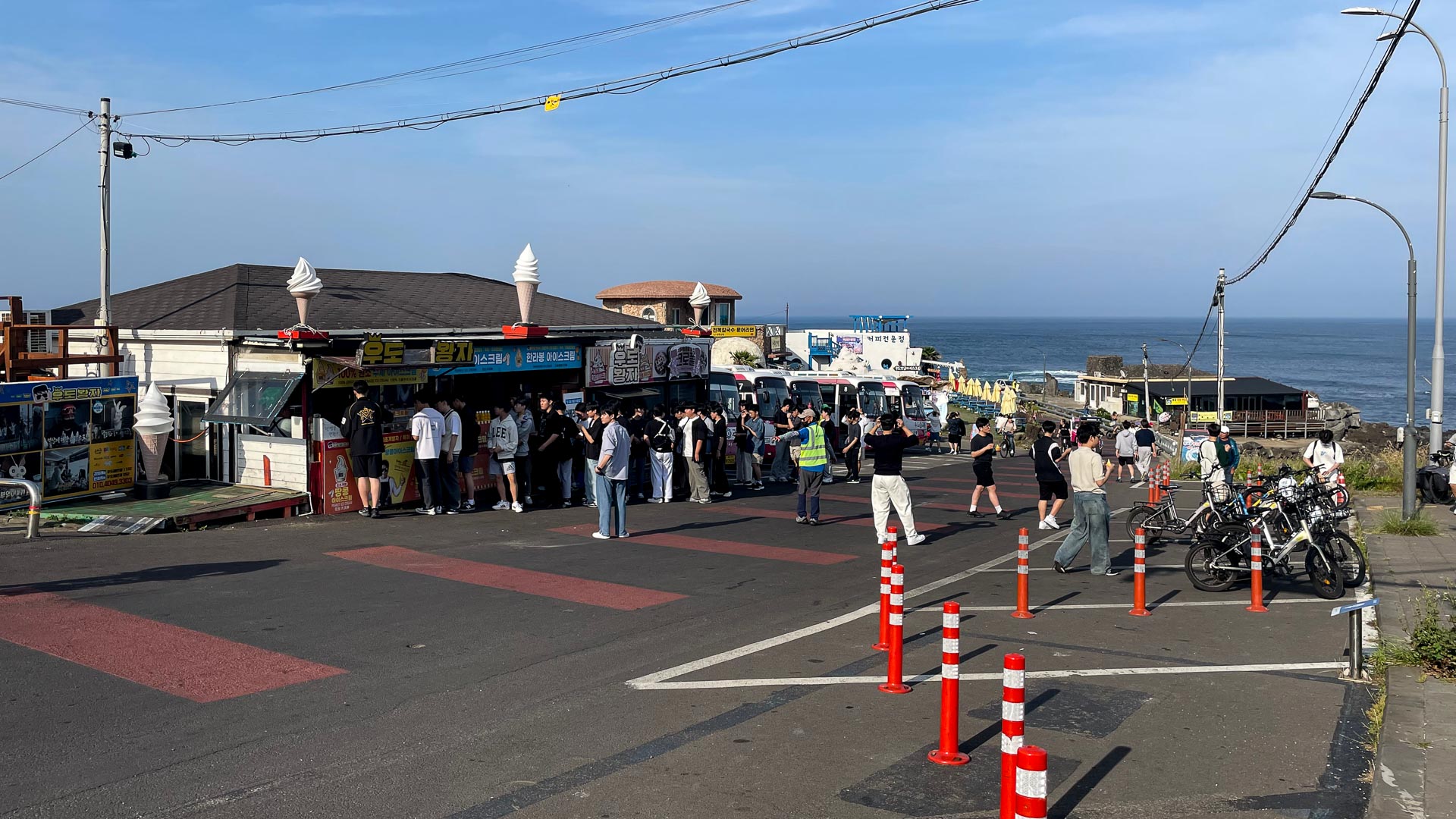
Looking at the island’s current state of development, it seems this survivalist attitude has taken a new form in a full-on commitment to touristic development. In 2022, nearly 13.9 million people traveled to the island, pushing the year’s tourism revenue above 7.6 trillion won (roughly $5.5 trillion), according to Yonhap News. Even so, locals are still toiling. Recent news coverage has noted that the industry is struggling to bounce back from the Covid pandemic. In particular, it’s been unable to keep the attention of domestic travelers, who reportedly find Jeju’s food and accommodations unjustifiably expensive. According to the Jeju Tourism Association, in May, domestic tourist numbers fell 8.4 percent compared to last year. Increases in foreign tourist numbers have not made up the deficit.
During a short prior visit to Jeju in March that coincided with cherry blossom season, major tourist stops like the Osulloc Tea Museum and Hallim Park seemed busy enough. In May, when I first noticed the lack of crowds, I simply thought my friend and I were visiting less popular places or eating too late and missing the rush. By the end of our trip, however, we’d started making jokes about how often our only company at famous sites were roving bands of adolescent boys on school trips. Where were all the families, the girls’ trips, the honeymooners?
Meanwhile, visitors who want to learn about Jeju’s history and culture must really search for it. Signs around the island—on the coastal walking trails, near historical sites, or next to the ruins of Japanese forts—offer small insights into Jeju’s story, but to put them in any context, tourists would need to make a day of it.
While luxury resorts are concentrated around Jeju City in the north, most visitors tend to stay on the western and southern coasts. But historical and cultural sites like the Jeju Haenyeo Museum, Jeju Stone Culture Park, Gwaneumsa Temple and Jeju 4.3 Peace Park—a memorial park and museum commemorating the more than 14,000 victims of the 1948-9 massacre—are all in the northeast.

And it’s definitely not common to seek out that kind of information. The owner of my pension—a friendly Seoul transplant who diligently handwrote tour itineraries for us each morning—politely ignored me the first time I mentioned an interest in learning about the massacre. The second time, she said, “Oh, but that’s such sad history,” and suggested we visit a Snoopy-themed garden instead. I politely ignored her, too.
Maybe that makes me a bit of a snob. Not all vacationers will feel this way, and in particular, families with small children would probably do well in Jeju. But I would love to see Jeju’s history, even the painful parts, highlighted as the years go forward, for its important sites to be protected from runaway development. And at least some Jeju locals—the ones running these cultural institutions—seem to agree. Lately, tourism websites have urged visitors to take more interest in the island’s past: “If you do not know about its painful history,” one site says of the Jeju 4.3 Incident, “then your tour can only be half complete.” Jeju’s government, too, has several citizen policy teams dedicated to celebrating local culture and protecting its citizens’ quality of life amid the tourism boom.
When asked about history and culture-focused tourism initiatives, Lee Min-gyu, digital marketing team leader at the Jeju Tourism Organization, responded that the organization promotes tourism by “leveraging the island’s diverse culture, history, and the proud natural heritage recognized by three UNESCO designations.” In addition to recognizing haenyeo culture, UNESCO has also named three World Natural Heritage Sites on Jeju: Mt. Halla, Seongsan Ilchulbong Peak and the Geomun Oreum lava tubes system. The organization’s new social media campaign for sustainable tourism even includes “a commitment to uphold and preserve Jeju’s unique culture” as a core tenet.
However, Lee also noted that the government-funded tourist group’s work is heavily shaped by consumer trends. Its May 2024 Market Trends report, which used online search engine rankings to measure public interest in attractions, showed that tourists are keenly interested in Jeju’s nature—but not so much in cultural institutions. Search results included a couple traditional markets, but the names of historical museums, monuments and even haenyeo-related search terms were notably absent.

That’s a shame because visiting the Jeju 4.3 Peace Park and Memorial Hall was a powerful, if jarring, experience. Just beyond the limits of Hallasan National Park in the island’s northeast, the museum’s campus features several large monuments and sculptures set in a vast, manicured lawn. Its historical exhibit, a dimly lit labyrinth in its Memorial Hall, explains how the Jeju Uprising, an armed revolt against the nascent South Korean government and US military that started on April 3, 1948, began in response to an incident of police brutality the prior year that had left six people dead. In response to the uprising, the US military cracked down on protesters, making thousands of arrests, and once elected, the pro-US president Syngman Rhee employed a scorched-earth strategy, burning villages to the ground and indiscriminately killing civilians. By the end, more than a ninth of the island’s population had been killed.
The exhibition reads like it’s building a case, with every statement of events accompanied by photographs, quotes and other evidence to ward off accusations of editorialization. It makes sense; for decades, Seoul actively suppressed the history of the 4.3 Incident, and many still assert that government action was justified to suppress violent, communist rioters. Calls for the US to apologize for its role in the event have also grown stronger in recent years. As I walked through the exhibit, reading shocking quotes from US military leaders and listening to its constant, haunting loops of “Battle Hymn of the Republic,” I could feel the curators’ anger and desperation for accountability.
Later parts of the exhibit also make clear that the 4.3 Incident is a living trauma, visible in scars on survivors’ bodies as well as in important absences, like the absence of those destroyed mountain villages, or of the thousands of refugees who fled to the mainland or Japan and have been unable or unwilling to return.
It feels important to know this history, both as a consumer of Jeju tourism and as a US citizen. To me, Jeju’s craggy shores had felt suffused with melancholy. The stories above about the unlikely survival of Jeju’s people could have been triumphant or boastful ones, but instead, they seemed full of resignation. Jeju 4.3 Peace Park explained one aspect of this atmosphere and showed me how Jeju’s difficult past continues to affect its culture and people to this day.
Modernity is reshaping the island quickly and without hesitation, but as Kwon told me in our interview about the haenyeo, there is still time to protect and preserve what makes Jeju unique.
“There are still 2,800 female divers on Jeju island, not including those who have retired. It is a living cultural heritage,” she said in her usual matter-of-fact tone. “We have to preserve it because it’s unique.”
Top photo: Hallasan National Park in the center of Jeju

